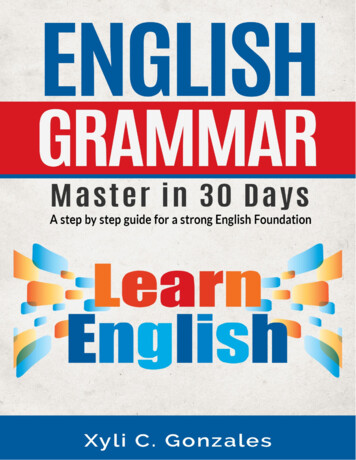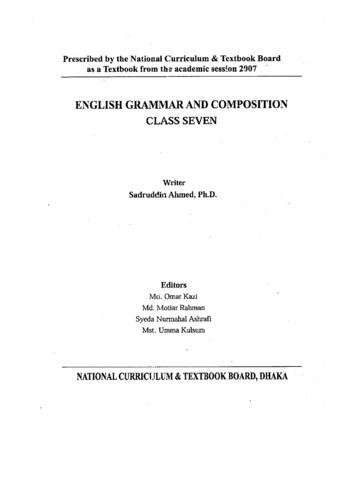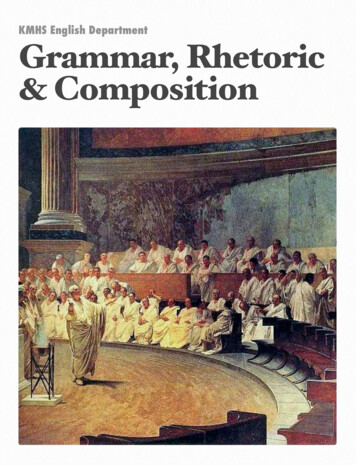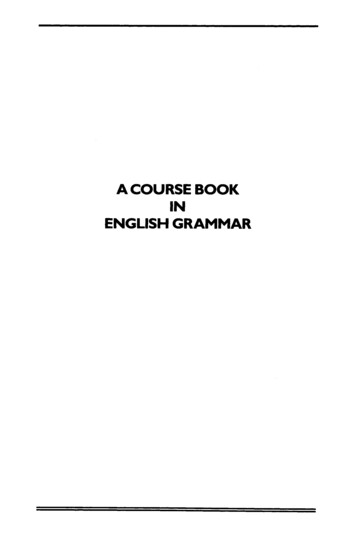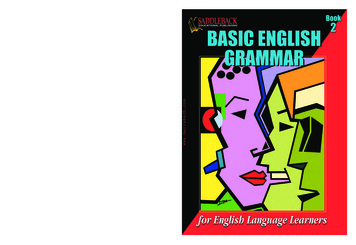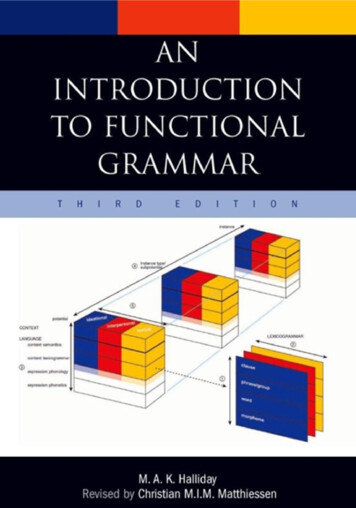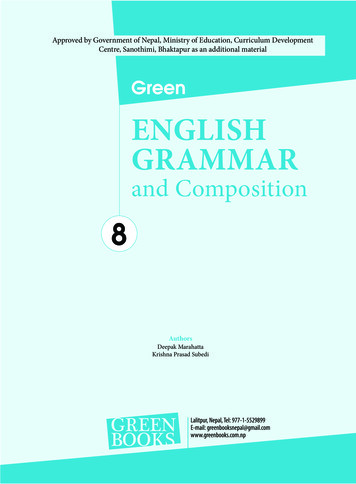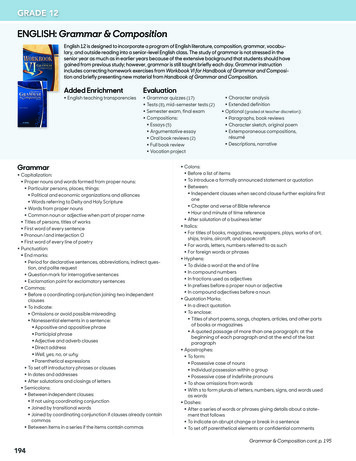
Transcription
GRADE 12ENGLISH: Grammar & CompositionEnglish 12 is designed to incorporate a program of English literature, composition, grammar, vocabulary, and outside reading into a senior-level English class. The study of grammar is not stressed in thesenior year as much as in earlier years because of the extensive background that students should havegained from previous study; however, grammar is still taught briefly each day. Grammar instructionincludes correcting homework exercises from Workbook VI for Handbook of Grammar and Composition and briefly presenting new material from Handbook of Grammar and Composition.Added Enrichment English teaching transparenciesGrammarEvaluation Grammar quizzes (17) Tests (8), mid-semester tests (2) Semester exam, final exam Compositions: Essays (5) Argumentative essay Oral book reviews (2) Full book review Vocation project Capitalization: Proper nouns and words formed from proper nouns: Particular persons, places, things: Political and economic organizations and alliances Words referring to Deity and Holy Scripture Words from proper nouns Common noun or adjective when part of proper name Titles of persons, titles of works First word of every sentence Pronoun I and interjection O First word of every line of poetry Punctuation: End marks: Period for declarative sentences, abbreviations, indirect question, and polite request Question mark for interrogative sentences Exclamation point for exclamatory sentences Commas: Before a coordinating conjunction joining two independentclauses To indicate: Omissions or avoid possible misreading Nonessential elements in a sentence: Appositive and appositive phrase Participial phrase Adjective and adverb clauses Direct address Well, yes, no, or why Parenthetical expressions To set off introductory phrases or clauses In dates and addresses After salutations and closings of letters Semicolons: Between independent clauses: If not using coordinating conjunction Joined by transitional words Joined by coordinating conjunction if clauses already containcommas Between items in a series if the items contain commas Character analysis Extended definition Optional (graded at teacher discretion): Paragraphs, book reviews Character sketch, original poem Extemporaneous compositions,résumé Descriptions, narrative Colons: Before a list of items To introduce a formally announced statement or quotation Between: Independent clauses when second clause further explains firstone Chapter and verse of Bible reference Hour and minute of time reference After salutation of a business letter Italics: For titles of books, magazines, newspapers, plays, works of art,ships, trains, aircraft, and spacecraft For words, letters, numbers referred to as such For foreign words or phrases Hyphens: To divide a word at the end of line In compound numbers In fractions used as adjectives In prefixes before a proper noun or adjective In compound adjectives before a noun Quotation Marks: In a direct quotation To enclose: Titles of short poems, songs, chapters, articles, and other partsof books or magazines A quoted passage of more than one paragraph: at thebeginning of each paragraph and at the end of the lastparagraph Apostrophes: To form: Possessive case of nouns Individual possession within a group Possessive case of indefinite pronouns To show omissions from words With s to form plurals of letters, numbers, signs, and words usedas words Dashes: After a series of words or phrases giving details about a statement that follows To indicate an abrupt change or break in a sentence To set off parenthetical elements or confidential commentsGrammar & Composition cont. p. 195194
GRADE 12ENGLISH: Grammar & Composition cont.Grammar cont. Parentheses: To enclose: Parenthetical elements Brief confirmatory information Brackets: To enclose editorial comments within quotations To replace parentheses within parentheses The sentence: Definition of sentence Kinds of sentences classified by purpose: declarative, imperative,interrogative, exclamatory Recognizing subjects and verbs: complete subject, simple subject,complete predicate, simple predicate, and verb phrase Overcoming problems locating subjects and verbs: Finding: Subject in an inverted sentence: interrogative sentence,sentence beginning with there or here Subject of an imperative sentence Subject before its appositive Verb phrase that is interrupted by other words Diagramming subjects and verbs Recognizing and diagramming compound subjects and verbs Recognizing and diagramming complements: direct object,indirect object, objective complement, predicate nominative,predicate adjective Fragments and run-on sentences Recognizing and diagramming simple, compound, complex, andcompound-complex sentences Sentence improvement: Unity and coordination Subordination: Choosing what to subordinate Avoiding upside-down, illogical, and excessive subordination Placement of modifiers: Avoid: Squinting modifiers and split constructions Dangling participial phrases Dangling gerund and infinitive phrases Elliptical clauses Pronoun reference Clear and logical construction Parallelism Point of view: Avoid unnecessary shifts in: Subject, voice, and tense Mood, person, number, discourse, and tone Consistency of subject, tense, or voice Clear and effective diction Conciseness Parts of speech: Recognizing eight parts of speech Verbs: Recognizing action (transitive and intransitive), linking, andhelping verbs Distinguishing verbs from verbals: participles, gerunds, andinfinitives Using principal parts of verbs Regular verb endings Irregular verbs Using correct principal parts Verb tenses: progressive and emphatic forms When to use the verb tenses Using logical verb tense sequence between clauses andbetween verbals and independent clause Avoiding unnecessary shifts in sentences: in subjects, verbtense, voice of verbs Active and passive voice Mood: indicative, imperative, and subjunctive Avoid incorrect verb forms Use troublesome verbs correctly and avoid verb usage errors Nouns: Recognizing nouns: Compound, common, proper, and collective Concrete and abstract Substantives Keeping agreement of subject and verb Recognizing and diagramming nouns as predicate nominatives,direct objects, indirect objects, objects of prepositions, directaddress, appositives, and objective complements Using parallelism Pronouns: Antecedents Recognizing personal, interrogative, demonstrative, indefinite,compound, relative Recognizing reflexive and intensive pronouns Keeping agreement of verbs and indefinite pronoun subjects Making pronouns agree with their antecedents: In number and in gender In person Nominative case: For subjects, predicate nominatives, appositives of subjects,appositives of predicate nominatives, appositives to subjects,and appositives to predicate nominatives For complements of the infinitive to be Objective case: For direct objects, indirect objects, objects of prepositionsand for appositives of direct objects, indirect objects, objectsof prepositions and for appositives to direct objects, indirectobjects, and objects of prepositions For subjects of infinitives and complements of the infinitive to be Possessive case: Using correct case for who, whom, whoever, and whomeverand in incomplete clauses beginning with than or as Avoid pronoun usage problems: double subject, possessivecase before a gerund Adjectives: Recognizing and diagramming adjectives: Participles and properadjectives and infinitives as adjectives Distinguishing adjectives from nouns and pronouns Recognizing and diagramming predicate adjectives Using and diagramming: Prepositional and participial phrases as adjectives Infinitive phrases as adjectives Adjective clauses Placing and punctuating adjective modifiers Using adjectives in comparison Avoiding double comparison and double negativesGrammar & Composition cont. p. 196195
GRADE 12ENGLISH: Grammar & Composition cont.Grammar cont. Adverbs: Recognizing and diagramming adverbs Infinitives as adverbs Nouns as adverbs Distinguishing adverbs from adjectives Using and diagramming: Prepositional phrases as adverbs Infinitive phrases as adverbs Adverb clauses Correct placement of adverb modifiers Distinguishing dependent clauses Using adverbs in comparison Prepositions: Recognizing prepositions, prepositional phrases, and objects ofprepositions Distinguishing between prepositions and adverbs Using prepositions correctly Conjunctions: Recognizing coordinating, correlative, and subordinatingconjunctions Using parallel structure Interjections: Definition Punctuation with interjections Other parts of speech used as interjections Diagramming interjections Recognizing and diagramming: Nominative absolute and expletives Nominative absolute phrases Word study: Using the dictionary: Kinds of dictionaries Selecting a dictionary Using the dictionary Parts of the dictionary Usage and diction: Levels of usage Using correct diction Using clear and effective diction Appropriateness Exactness and vividness Figurative language Gobbledygook Jargon Triteness Wordiness: Sentences beginning with there, it, and this Wordy expressions Redundancies Glossary of dictionComposition Manuscript form: Abbreviations, numbers, titles Abbreviations in footnotes and parenthetical references The Writing Process: plan, write, rewrite, edit196 RED indicates first introduction of content. Introducing paragraphs: Topic sentence Summarizing sentence Paragraph development by examples, incidents, reasons, comparison and contrast, and combination of methods Paragraph unity Paragraph coherence: chronological order, order of importance,transitional expressions, space order, pronoun reference, andrepetition Paragraph with proper emphasis Essays (6): Essay answer Narrative and argumentative essays Outline: Topical and sentence outlines Format of outline Parallelism in an outline Steps to preparing an outline Extended definition Writing descriptions about persons, places, and things (6): Steps: point of view, careful selection of details, arrangement ofdetails, use of exact nouns and verbs Character sketch Critical book reviews: written and oral review Writing letters: Friendly: letter parts, thank-you note, bread-and-butter note Business: Letter parts, order letter, request letter, complaint letter, andletter to a government official Letter of application, résuméhh Vocation Project (Research paper): Planning the paper: Selecting subject Finding sources: encyclopedia, periodical databases, Essay andGeneral Literature Index, published bibliographies Writing bibliography cards Making a preliminary outline Taking notes: writing note cards, avoiding plagiarismhh Writing a questionnaire cover letter and conductingan interview Writing the paper: introduction, body Using parenthetical citations Rewriting the paper: check organization, introduction, conclusion,unity, coherence, and citations Editing the paper: check each paragraph, sentence, word;capitali zation and punctuation Typing the paper: General information Formatting pages: title page, pledge page, outline page, firstpage, and succeeding pages Inserting footnotes or endnotes Additional guidelines: Abbreviations in citation entries Ellipsis marks in quotations Block quotations Documentation for research paper: Parenthetical citations Endnotes and footnotes Typing instructions
GRADE 12ENGLISH: Vocabulary, PoetryKnowing and using a selection of choice vocabulary words gives high school students an advantage, whetherit is in a job interview, on a college entrance exam, or simply in meeting today’s expectations for expressionand communication. Mastering the vocabulary words in Vocabulary, Poetry VI will help students in their writing, speaking, and reading comprehension. Many of the words are taken from English Literature. Students willstudy the antonyms and synonyms included with the definitions and learn prefixes, root words, and suffixes,expanding their vocabulary even further. Students will also memorize ten poems throughout the year. Thestudents will benefit from reciting and memorizing poetry.Added Enrichment Vocabulary lists (12): Total words and definitions (144) Organized by word origin or byroots, prefixes, and suffixes Practice exercises (100) including: Pretest over vocabulary wordsand their meanings Cumulative review of vocabularywords and definitions Each vocabulary word includes: Pronunciation, etymology,part of speech Definition, sample sentence Synonyms, antonyms Related forms of the word Pronunciation key Vocabulary chart showing: Prefixes (48), suffixes (48) Greek and Latin roots andmeanings (100) Guidelines for solving analogyquestions Index includes vocabularywords; prefixes, roots, suffixes;synonyms antonymsEvaluation Weekly quizzes (8) Quarterly review (1 each 9 weeks;each counts as 2 quiz grades) Poetry quizzes: written (9),oral (1) RED indicates first introduction of content.Skills DevelopmentPoetry Skills Development Use vocabulary words in sentences and in proper context Memorize vocabulary definitions Master 48 prefixes, 100 roots, and 48 suffixes Learn more than 1,000 synonyms, antonyms, and related words forvocabulary words Analyze word meanings based on their prefixes, roots, and suffixes Develop ability to solve analogy questions Apply spelling and phonics concepts through teacher-directed oralpractice and independent written practice Develop appreciation for poetry Lay foundation for future literature study Recite in unison Use appropriate expression and volume Increase vocabulary Demonstrate comprehension of emotion and content Develop a mental visualization of the poem Discuss meaning and purpose of poems Use proper punctuation in writing and reciting poemshh Master vocabulary words and definitionshh Memorize 10 lyrical poemsENGLISH: LiteratureEnglish Literature presents a chronological study of English literature from the Anglo-Saxon period to theModern Age (twentieth century). Classics such as Beowulf, The Importance of Being Earnest, Pride andPrejudice, Paradise Lost, Robinson Crusoe, David Copperfield, and The Canterbury Tales were chosen notonly for their literary value but also for their character development. Students will learn about a variety ofliterary genres and will further analyze literature through in-depth studies of a tragedy, an allegory, and anovel. In order to help students visualize the works and time periods they are studying, English Literaturecontains a variety of illustrations and photographs of English people, places, and art.Literary Value 105 authors, including well-knownwriters such as Elizabeth Barrett Browning, Geoffrey Chaucer,Daniel Defoe, Charles Wesley, andOscar Wilde Prose selections (24), poems (221),plays (4), essays (13), devotionalworks (7), and sermon (1)Added Enrichment Footnotes define and explainunfamiliar words Comprehension and discussionquestions after selections Character-building quotationsand verses Introductory paragraphs forinterest and background information Author biographies and literaryterms Glossary of literary terms Unit reviews Introduction to each literaryperiod describing literary characteristics of that ageEvaluation Comprehension quizzes (22) Homework reading quizzes (29) Tests (8), 9-weeks exam (2) Semester exam, final examLiterature cont. p. 198197
GRADE 12 RED indicates first introduction of content.ENGLISH: Literature cont.Reading Skills Development Develop skills in reading comprehension Further develop oral reading skills Be able to identify significant quotations and the selections in whichthey are featured Increase vocabulary Further develop writing skillshh Study various literary forms: lyric and epic poetry, drama, allegory,Romantic and Victorian poetry, and modern fiction Study meaning and use of literary terms and devices such as theme,plot, imagery, figurative language, analogy, aside, caesura, carol,exemplum, idyll, kenning, madrigal, metonymy, ode, rondeau, scop,currealism, and terza rima Study historical backgrounds and writing techniques to betterunderstand each literary periodhh Study the development of plot, theme, setting, and character(s) inshort stories, essays, and other notable works of English literatureComprehension, Discussion, & AnalysisSkills Developmenthh Read entire works: The Pilgrim’s Progress and Macbeth Develop proper discernment according to the truths of Scripture Answer factual, interpretive, and inferential comprehension anddiscussion questions Improve ability to use deductive reasoning, understand causeand effect, and draw conclusions Build appreciation for good literature and a love of reading Develop an understanding of people’s motives and feelings whilerecognizing consequences of particular actions Learn to analyze literature while studying selections Comprehend and appreciate the basic elements of a work ofliterature Learn to appreciate the rhyme, rhythm, and figurative languageof poetryMATHEMATICS: PrecalculusThe purpose of Precalculus is to teach the student how to select and apply various techniques to solvemathematical problems in a skillful, systematic, and logical manner. Students will learn the underlying principles of trigonometry and interrelationships of lines and functions with graphical and analyticalproblem-solving techniques from a study in analytical geometry. The study culminates with an introductionto selected calculus topics.Also available: Consumer Mathematics and Business Mathematics on Electives pp. 199-203.Topical Interest Essays The History of Pi Distance of travel due to earth’s rotation Mathematics in Astronomy—Eratosthenes’ calculation of earth’s c ircumference Sir Isaac Newton Oscilloscope Measurement of HouseholdVoltage Mathematics in Engineering The Place of Imaginary Numbers Euler’s Formula e i 1 0 Missile Guidance Technology Mathematics in Physics—Projectile Motion Mathematics in Biology Summation—A Calculation of Pi The Design of Cylindrical Containers Mathematics in Physics—Fluid pressure on avertical surfaceEvaluation Quizzes (49) Tests (9) 9-weeks exam (2) Semester exam Final exam RED indicates first introduction of content.Trigonometry & Analytical Trigonometry Basic trigonometric ratios Solving right triangleshh Advanced trigonometric ratioshh Trigonometric functionshh Solving trigonometric equations Trigonometric graphs: Interceptshh Symmetry, sinusoidhh Amplitude, period, key angles, key pointshh Vertical and horizontal scalinghh Vertical and horizontal translationhh Phase shifthh Vertical asymptoteshh Signs of the functions by quadranthh Periodic motion: simple harmonic motion, frequency, rotatingobject, suspended objecthh Identities:hh Reciprocal, cofunction, Pythagorean, quotienthh Negative angle, double angle, half anglehh Sum and difference, product to sum, sum to producthh Verifyinghh Used to find unknown values Special angle function values (30 , 45 , etc.; 6 , 4 , etc.) Inverse function values using a calculator Function values: Angles in degreeshh Angles in radianshh Finding unknown function valueshh Function values using the unit circle, line diagrams of functionvalues Using a calculator, using right triangles, using special triangles: 30 -60 -90 45 -45 -90 90 ; 6 - 3 - 2 , 4 - 4 - 2hh Reducing trigonometric function angles: reference angle, referencetrianglehh Rewriting as a cofunctionPrecalculus cont. p. 199198
GRADE 12 RED indicates first introduction of content.MATHEMATICS: Precalculus cont.Coordinate Geometry Basic review, terminologyhh Trigonometric Function graphs:hh Intercepts, symmetry, sinusoidhh Amplitude, period, key angles, key pointshh Vertical and horizontal scalinghh Vertical and horizontal translation, phase shifthh Vertical asymptoteshh Angles in degrees and radianshh Graphing by addition of ordinateshh Inverse functions, inverse trigonometric functions Intercepts: x-intercept, y-intercepthh Symmetry: x-axis, y-axis, origin Domain: Limiting operationshh Determining Complex number plane Points of intersection Distance Slope:hh Variation, inclination Parallel and perpendicular lineshh Angle between two intersecting lines Straight line:hh Inclinationhh Distance to a point Systems of lines Equation forms: Slope-intercepthh Point-slope, two-point, intercept, parallel to axes, general Midpoint Parametric equations:hh Eliminating the parameterhh Developing equations: Shrödinger’s wave model graphhh Involute of a circle, brachistochrone, cycloids Locus of a pointhh Conic sections: Circle: center, radius Ellipse:hh Vertexes, foci, major and minor axes, latus rectum, eccentricity Parabola: Vertexhh Focus, latus rectum, eccentricityhh Hyperbola: vertexes, foci, transverse and conjugate axes, latusrectum, eccentricity, asymptotes, conjugate hyperbolashh Horizontal and vertical translation, rotation of axeshh Graphing in three dimensions:hh Traces, cylinders, elementshh Graphs: ellipsoid, paraboloid, hyperboloid of one sheet, hyperboloid of two sheets, hyperbolic paraboloid, coneAngles Angles on the Cartesian plane: In degreeshh In radianshh Initial side, terminal side, standard positionhh Quadrant of an angle, coterminal angles, positive and negativeangles: in degrees, in radians, conversionshh Bearinghh Key angles for a trigonometric function graph Trigonometric function values:hh Reference angle by quadrant: in degrees, in radians Special angles: 30 , 45 , etc.; 6 , 4 , etc.Functions Functional notation Domain and range:hh Finding, using inequalities, using intervals, characteristicshh Functions: even, odd, periodic, inversehh Horizontal line test, vertical line test, one-to-one functionsTriangles Solving right triangleshh Solving oblique triangles: Law of sines, law of cosineshh The ambiguous case Using angles of elevation and depression Finding area Right triangle trigonometryhh Reference triangle 30 -60 -90 , 45 -45 -90 ; 6 - 3 - 2 , 4 - 4 -Complex Numbers Imaginary numbers and basic quantities Standard form Graphing on the complex planehh Magnitude, argument, trigonometric form, polar form, conversionshhMultiplying and dividing complex numbershhFinding roots and powers: De Moivre’s theoremDistance Length of an arc: Using degreeshh Using radians Distance between two points: In two dimensionshh In three dimensionshh Horizontal and vertical distancehh From a line to a pointVectorshh Scalar, equal vectors, unequal vectors, negative vector, resultant,vector sumPolar CoordinatesRegression Analysishh Terminology, conversionshhClose-fit curvehh Graphing techniqueshh Analysis techniques: branch tangents at the pole, symmetry, etermining angles resulting in undefined valuesdhh Rotation of axeshh Graphs: lines, circles, roses, cardioids, limaçons, parabolas4hhMethod of least squares: general equations for solutionhhSummation notationhhPearson-r correlation coefficienthhLinear and non-linear data: yy a bx cx2 . mxn mx b, y aetx, y axt,Precalculus cont. p. 200199
GRADE 12MATHEMATICS: Precalculus cont.Introductory Calculushh History, limitshh First derivative of a polynomial: using limits, using the short methodhh Slope using derivativeshh Second derivative of a polynomial: maximum and minimum,critical points Rate of change: Averagehh Instantaneous RED indicates first introduction of content. Velocity: Averagehh Instantaneous Acceleration: Averagehh Instantaneoushh Anti-derivativehh Area under a curveHISTORY & GEOGRAPHY: American Government (one semester)American Government in Christian Perspective seeks to give students a clear understanding of thehistorical and philosophical elements that make the United States a unique nation. Only when studentsfully understand these foundational elements will they be able to love and appreciate our republic.American Government in Christian Perspective traces the roots of our political institutions and examinesthe Constitution itself. Through a clear explanation of the legislative, executive, and judicial branches ofgovernment, students learn how a republic actually functions. Students will also study state and localgovernment and be better able to understand their local systems, which will in turn develop a betterunderstanding of and a greater appreciation for American philosophy and ideology.Added Enrichment Special feature boxes (44): Give better understanding of the following: Foundations of American liberty Operation of opposing government systems Symbols of American government Concepts of American government Highlight those who have helped shapeAmerican government through their writingsand biographical sketches Important U.S. documents: the Constitutionof the United States, the Declaration of Independence, and the Articles of Confederation State and Local Government (5 sections) Helps students understand the state andlocal government by completing the studyoutline for their stateEvaluation Reading quizzes (15) Review quizzes (19); (includes memorizationquizzes for “The Star-Spangled Banner,” thePreamble to the Constitution, and four Scripturepassages totaling 15 verses) Current events (14; each counts as quiz grade) Patriotic project (counts as test grade) Tests (4), 9-weeks exam (1) Final exam RED indicates first introduction of content.Foundations of American Governmenthh America—a unique nation:hh Miracle of America:hh A blessed nationhh American characterhh Need for vigilancehh American symbolshh Patriotism versus nationalismhh Government under God:hh Foundations of civil government: nature of governmenthh Forms of government:hh Theocracy and human governments Constitutional republichh Dictatorshiphh Christians and government:hh Christian’s response and responsibilities to governmenthh Character and government Shaping of the American republic: English heritage: Bible and Christianity in England English common law and government Struggle for liberty English tradition takes root in America: Compacts, colonies, and charters Colonial law and government Local government Steps toward unity: Spiritual revival in the colonies Early efforts at political union A nation is born: Steps toward independence Independence declaredOur Constitutional Republic Constitution of the United States: From Plymouth to Philadelphia: Roots of America’s Constitution Articles of Confederation New Constitution adopted: Constitutional Convention, 1787 Bundle of compromises Federalists and Anti-Federalists Main features of the Constitution: Supreme law of the landhh Purposes of our governmentAmerican Government cont. p. 201200
GRADE 12 RED indicates first introduction of content.HISTORY & GEOGRAPHY: American Government cont.Our Constitutional Republic cont.hh Rights and responsibilities of the American peoplehh Republican and limited government Congress—legislative branch:hh Structure of Congress:hh Congressional houses and leadershiphh Constitutional qualificationshh Procedures within Congress: process, pay, privileges, and penaltieshh Responsibilities of Congress:hh Lawmaking and the processhh Representation and oversighthh Powers of Congress that they can and cannot exercise President—executive branch:hh President and the Constitution: creation, term, tenure,qualifications, succession, and compensationhh President’s leadership: constitutional powers and God-givenauthorityhh Vice Presidenthh Roles of the President: chief of state, commander in chiefhh President’s team:hh White House officehh Office of Management and Budgethh Other advisory bodies Bureaucracy—executive branch: From patronage to a merit system Growth of the bureaucracyhh Organization of the bureaucracy:hh Executive departmentshh Agencieshh Government corporationshh Power of the bureaucracy:hh Bureaucracy and the Constitutionhh Legacy of expanding bureaucracyhh Reform of the bureaucracy: reorganization, reduction, andremoval Federal Courts—judicial branch:hh Constitutional and legislative courts: nominating federal judgesand justiceshh Judicial process:hh Civil and criminal caseshh Procedure in a trial court and an appeals courthh Supreme Court: Judicial review: Marbury v. Madisonhh Legal road to the Supreme Courthh Court in sessionhh Changing role of the Court: Earl Warren Bill of Rights and other amendments: Bill of Rights: Background of the Bill of Rightshh Our civil rights and responsibilities Original meaning of separation of church and statehh Other amendmentshh Importance of various court casesOur Federal Republichh American federalism:hh Federalism definedhh Constitution and federalism: dividing power and fulfilling obligationshh History of federalism: rise of central power:hh Dual, cooperative, and coercive federalismhh Federalism today:hh States and the Supreme Courthh States and Congress: the 10th Amendmenthh State and local government:hh Fifty individual states:hh State constitutions and the federal Constitutionhh Changing states constitutionshh Functions of state governmenthh State executive officershh State legislators:hh Terms, sessions, and apportionmenthh Qualifications, elections, compensation, and personnelhh Powers of the state legislaturehh Officers and organization of the state legislaturehh Legislative processhh
ENGLISH: Grammar & Composition English 12 is designed to incorporate a program of English literature, composition, grammar, vocabu-lary, and outside reading into a senior-level English class. The study of grammar is not stressed in the senior year as much as in earlier years because of the extensive background that students should have

